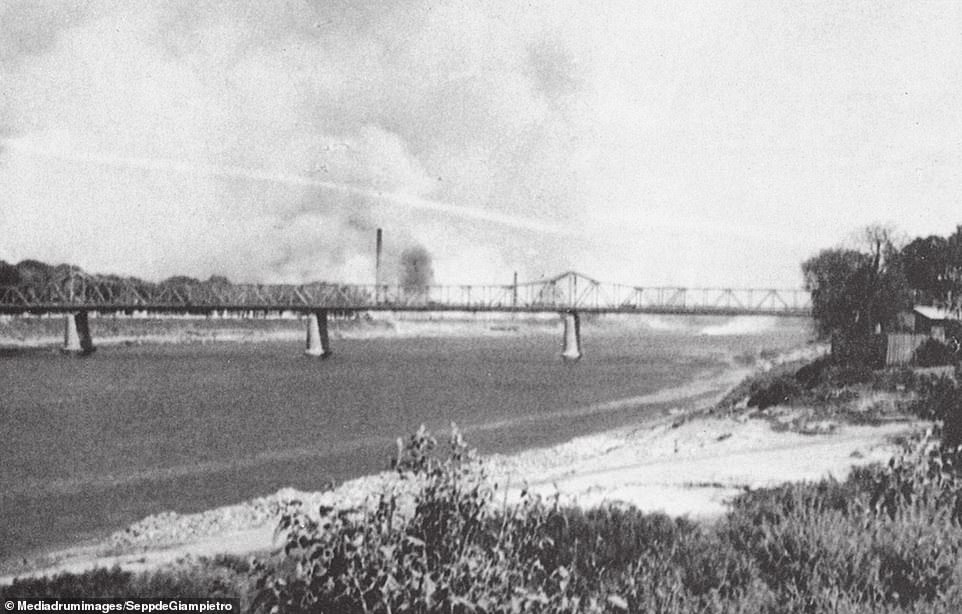
Conquest: The bridge over the Daugava river in
Daugavpils, Lithuania, is seen from the river bank with the city in the
background on fire. The city, called Dünaburg by the Germans, was captured and
secured at dawn on June 26, 1941 in a camouflage operation by the half-company
Knaak, of the 8th Company of the Brandenburg special forces. The Nazis occupied
it until 1944 when it was liberated but Latvia was re-absorbed into the Soviet
Union.
Devastation: The remains of a captured vehicle in
which the Brandenburger special forces, dressed in Russian uniform, had crossed
a bridge in Daugavpils, Latvia. The vehicle overturned and fell over the
embankment.
Oberleutnant Hans Wolfram Knaak, commander of the 8th
Company of the Brandenburg Regiment . On June 26th, 1941, Knaak and 30 of his
men, dressed in Soviet uniforms and driving captured trucks, drove through the
Soviet lines and seized the Dunaberg Bridges over the River Dvina. They held
the bridge against Soviet counterattacks, but by the time reinforcements arrived
20 minutes later, Knaak and 4 of his men were dead and 20 others had been
wounded. He was posthumously awarded the Knight’s Cross.
By June 24 General Erich von Manstein’s LVI Motorized Corps had reached the Daugavpils highway near Ukmerge, about 170 kilometers inside Lithuania.
Von Manstein was now within striking distance of the bridges
over the Daugava, about 130 kilometers away. Disregarding the fact that he had
outpaced his neighbors, he kept his units moving, ignoring flank protection.
Short, sharp engagements were fought against reserve Soviet tank units sent to
intercept him, but his orders were simple-“Keep going at all costs.”
With the spearhead of the 8th Panzer Division was a special
unit commanded by 1st Lt. Hans-Wolfram Knaak. In the early hours of June 26,
the 26-year-old Knaak detached his men from the spearhead and sped toward
Daugavpils in two captured Soviet trucks. Knaak and his troops were members of
the Lehr (Training) Regiment “Brandenburg”-commandos trained in
sabotage and subterfuge that were part of Admiral Wilhelm Canaris’s Abwehr
(Intelligence Service).
Many of Knaak’s men were fluent in Russian, and the two
trucks were able to make it through the Soviet defenses unmolested. The
drivers, in Red Army uniforms, joked with sentries and disseminated false
information concerning the German positions. Driving into Daugavpils, the
trucks headed for the precious bridges. The first truck almost made it to the
eastern side before sentries fired on it. Driving down an embankment, the men
in the rear of the truck jumped out with weapons firing.
The second truck, caught in the middle of the bridge, came
under heavy fire that resulted in several casualties. The survivors pushed
forward to link up with their comrades on the other side, and their combined fire
forced the Soviets back before engineers could arrive to blow the bridge. Some
of them were then able to make it to the nearby railroad bridge and succeeded
in cutting the detonation wires on that structure. Holding off attempts to
recapture the eastern side of the bridge, the Branden- burgers were soon
reinforced by the 8th Panzer spearhead, which had sliced through the Russian
lines. Following units took control of the city, and armor was soon massing to
meet the main body of Maj. Gen. Dmitri Danilovich Leliushenko’s 21st Mechanized
Corps, which was on its way to help the Russian defenses.
Knaak’s unit had won the day, but Knaak himself did not live
to see it. He had been killed during the fight for the crossing. For his
actions that day, he was posthumously awarded the coveted Knight’s Cross on
November 3, 1942.
As the German armor crossed at Daugavpils, the foot units of
von Wrede’s division followed in its wake. Although the 290th could not
possibly hope to keep up with the panzers, its advance served to widen the hole
punched through the Russian lines and guaranteed relative safety for von
Manstein’s supply lines. Hearing of von Manstein’s success, Hitler began
meddling in the affairs of Army Group North. In his war diary, General Franz
Halder, the chief of the General Staff of the Army, wrote, “Führer wants
to throw the whole weight of Armored Group Hoepner on Dvinsk. Possibilities of
a crossing at Jakobstadt
(Jekabpils) problematic.”
Von Leeb would have none of it. Reinhardt had defeated the
bulk of Kuznetsov’s armored forces, leaving the way open to the bridge at
Jekabpils. The movement to von Manstein’s sector would entail traveling through
wooded areas where few roads existed and would take days to accomplish. He
simply ignored any suggestions to change the original plan, giving Reinhardt
free rein to continue.
On June 27 the XLI Corps moved forward again. With a battle
group under the command of Brig. Gen. Walter Krüger, the 1st Panzer smashed the
remnants of the 12th Mechanized Corps, which were desperately trying to form a
line on the Musa River. At the same time, Stavka Chairman Marshal Semen
Konstantinovich Timoshenko ordered Kuznetsov to pull his remaining forces back
to join up with Berazin’s 27th Army, which was occupying positions along the
Daugava.
Battle Group Krüger moved on, spearheaded by the I/113th
Rifle Regiment under the command of Major Josef-Franz Eckinger. By 2300, the
battalion was 10 kilometers south- west of Jekabpils. At 0415 on the 28th, the
fight for the crossing began.
As at Daugavpils, a unit of Brandenburgers tried to take the
bridge by deception. This time the plan did not work, and the commandos found
themselves involved in heavy fighting. Soon the main elements of Colonel
Hans-Christoph von Heydebrand und der Lasa’s 113th Rifle Regiment joined the
fray. The Soviets were slowly pushed back, but Red Army engineers stood at the
ready. As the Germans advanced toward the Daugava, a series of explosions shook
the area. The bridges had been destroyed.